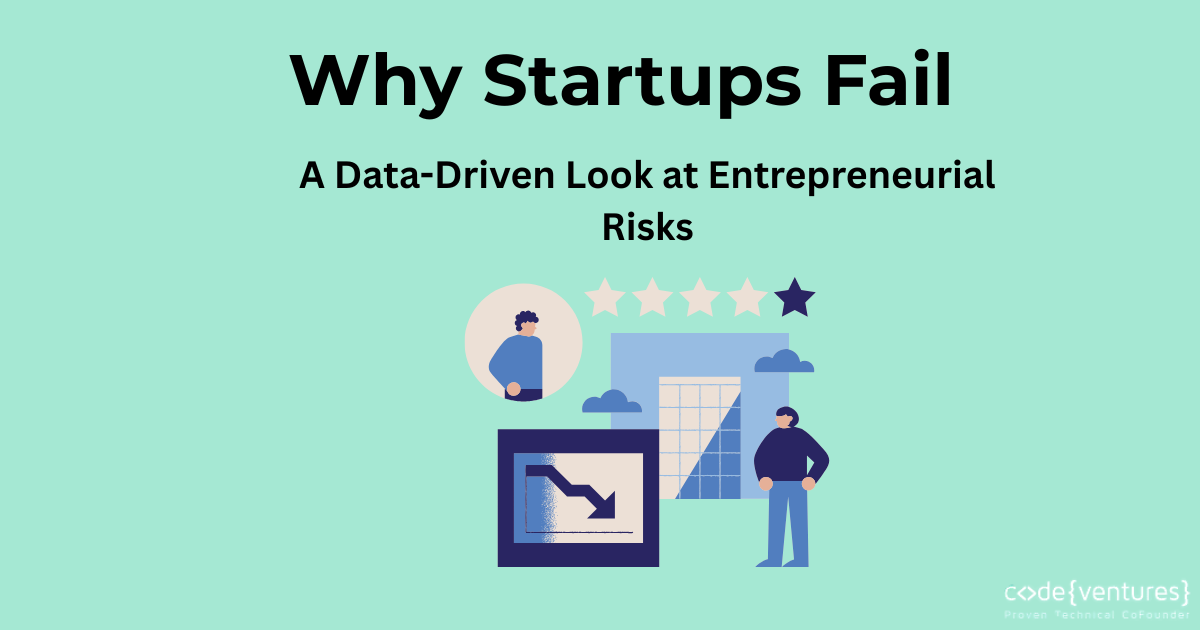Why Startups Fail A Data-Driven Look at Entrepreneurial Risks?

Starting a business is an exciting yet daunting journey. While success stories like Airbnb, Uber, and Slack dominate headlines, the reality is that 90% of startups fail (according to Failory). Understanding why startups fail is crucial—it empowers entrepreneurs to make better decisions, anticipate risks, and chart a smarter path to success.
In this blog, we’ll take a data-driven look at the most common reasons startups fail, backed by research and real-world examples.
1. Lack of Market Need (42% of Failures – CB Insights)
The number one reason startups fail is simple yet brutal: they build something that nobody actually needs. Founders often become deeply attached to their ideas, pouring time and money into products or services without validating whether real customers want them.
Example:
Take Quibi, for instance. Despite raising a staggering $1.75 billion, the mobile-first, short-form video streaming service failed within just six months of launch. The market simply wasn’t hungry for another subscription service filled with short videos, especially when platforms like YouTube and TikTok were already dominating.
Key Lesson:
Fall in love with the problem, not the solution. Startups must prioritize rigorous market validation before product development. There are startup incubators that helps entrepreneurs test ideas with minimal resources, ensuring they build something people actually need.
2. Running Out of Cash (29% of Failures)
Cash flow is the lifeblood of any startup. Many startups underestimate how much money they’ll burn through before reaching profitability—or they overestimate revenue projections. As a result, they run out of runway before they can pivot or scale.
Example:
One of the most infamous examples is Theranos, the biotech company that burned through $700 million without delivering a working product. The financial mismanagement combined with unrealistic projections led to one of the biggest startup scandals in history.
Key Lesson:
Detailed financial planning and conservative cash management are vital to survive long enough to find product-market fit. There are startup incubators that provide fundraising strategies for startups extend their runway and secure smart investments.
3. Poor Team Dynamics (23% of Failures)
A great idea is worthless without the right team to execute it. Startups often fail due to co-founder conflicts, skills gaps, or poor leadership. A team that isn’t aligned in vision, values, and work ethic can tear the business apart from within.
Example:
WeWork’s dramatic fall was fueled not just by a flawed business model but also by chaotic leadership and poor governance under its co-founder Adam Neumann. Despite massive funding and initial hype, the company’s internal dysfunction eventually became its undoing.
Key Lesson:
Building a strong, cohesive, and complementary team is just as important as building a great product.
4. Getting Outcompeted (19% of Failures)
Competition can crush startups that fail to differentiate themselves or adapt quickly. Markets are dynamic, and unless startups carve out a clear, compelling niche or innovate faster than their rivals, they risk being overshadowed.
Example:
Blockbuster is the classic cautionary tale. Despite being the dominant player in video rentals, they failed to recognize and respond to Netflix’s disruptive streaming model, ultimately leading to Blockbuster’s bankruptcy.
Key Lesson:
Stay hyper-aware of industry trends, customer needs, and competitive threats. Agility and innovation are survival skills.
5. Pricing & Revenue Model Issues (18% of Failures)
Getting the pricing strategy right is a balancing act. Price too high, and you alienate customers. Price too low, and you burn through cash without achieving profitability. Many startups struggle to find a sustainable revenue model.
Example:
MoviePass attempted to revolutionize moviegoing by offering an unlimited theater subscription for just $9.95/month. While customers loved it, the model was financially unsustainable, leading to huge losses and eventual collapse.
Key Lesson:
Startups must thoroughly research, test, and iterate on pricing and monetization strategies to ensure they are realistic and scalable.
6. Ignoring Customer Feedback (14% of Failures)
Startups that fail to listen to their customers often miss crucial insights that could have guided product improvements or pivots. In today’s hyper-connected world, ignoring feedback is a death sentence.
Example:
Juicero, which sold a $400 internet-connected juicer, is a prime example. When customers realized they could simply squeeze the juice packs by hand without the machine, the brand became the subject of widespread ridicule. Instead of responding nimbly to early criticisms, Juicero stubbornly stuck to its flawed concept, leading to its downfall.
Key Lesson:
Continuous feedback loops and customer-centric product development are non-negotiable for startup success.
Conclusion: How to Avoid Startup Failure
While failure is common, it’s not inevitable. By understanding and actively addressing the major reasons startups fail—such as market misalignment, cash mismanagement, team dysfunction, competitive pressures, pricing mistakes, and customer neglect—entrepreneurs can stack the odds more in their favor.
Building a startup is a marathon, not a sprint. Smart planning, adaptability, and relentless focus on real customer needs can dramatically improve the chances of making it to the finish line.